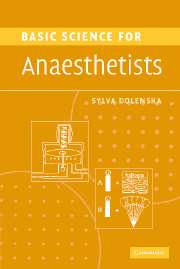Book contents
- Frontmatter
- Contents
- List of abbreviations and symbols
- List of figure captions
- Forewords
- Preface
- Preface to the second edition
- Part 1 Physics, mathematics, statistics, anaesthetic apparatus
- 1 Gas compression, relationship of volume, pressure and temperature
- 2 Real gas compression
- 3 Flow and resistance
- 4 Heat, vaporization and humidification
- 5 Simple mechanics 1: mass, force, pressure
- 6 Simple mechanics 2: work and power
- 7 Mathematical concepts
- 8 Exponentials 1: the curves
- 9 Exponentials 2: properties of exponential decay curve
- 10 Descriptive statistics
- 11 Presentation of data
- 12 Receiver operating characteristic curve
- 13 Gas supply and pressure
- 14 The circle system
- 15 The Mapleson A (Magill) breathing system
- 16 T-pieces
- 17 Lung filling with automatic lung ventilators
- Part 2 Clinical measurement
- Part 3a Physiology: the cardiovascular system
- Part 3b Physiology: the respiratory system
- Part 4 Pharmacology
- Further Reading
- Index
10 - Descriptive statistics
from Part 1 - Physics, mathematics, statistics, anaesthetic apparatus
Published online by Cambridge University Press: 13 August 2009
- Frontmatter
- Contents
- List of abbreviations and symbols
- List of figure captions
- Forewords
- Preface
- Preface to the second edition
- Part 1 Physics, mathematics, statistics, anaesthetic apparatus
- 1 Gas compression, relationship of volume, pressure and temperature
- 2 Real gas compression
- 3 Flow and resistance
- 4 Heat, vaporization and humidification
- 5 Simple mechanics 1: mass, force, pressure
- 6 Simple mechanics 2: work and power
- 7 Mathematical concepts
- 8 Exponentials 1: the curves
- 9 Exponentials 2: properties of exponential decay curve
- 10 Descriptive statistics
- 11 Presentation of data
- 12 Receiver operating characteristic curve
- 13 Gas supply and pressure
- 14 The circle system
- 15 The Mapleson A (Magill) breathing system
- 16 T-pieces
- 17 Lung filling with automatic lung ventilators
- Part 2 Clinical measurement
- Part 3a Physiology: the cardiovascular system
- Part 3b Physiology: the respiratory system
- Part 4 Pharmacology
- Further Reading
- Index
Summary
The purpose of statistical analysis is to obtain information from a sample that can then be extrapolated to a whole population; to analyse a whole population would be very lengthy, expensive and difficult to achieve. Care must be taken that the sample has the same characteristics as the target population (e.g. paediatric data cannot be extrapolated to the adult population).
Descriptive statistics categorise and summarise data. This chapter deals with summarisation of parametric (numerical) data.
To describe a population, or a sample, we should know its mode of distribution, a central point and its variability.
Variability is given by range, or by deviation from average. Only standard deviation is illustrated (but not derived) in this text.
Mode of distribution
Normal (Gaussian) distribution
This is the most frequent mode of distribution. The measured variable tends to cluster around the central, most common value, while extreme values either side of the centre are rare (e.g. adult male height, adult male haemoglobin). It is a bell-shaped curve only if the measurement was conducted in the whole population (e.g. the UK). Figure 31 shows the distribution of height in adult men. Observed values of height are plotted on the x-axis, and the frequency of observation (f) of each value is plotted against the y-axis. SD and x̄ in the graph stand for standard deviation (SD) and mean (see below). 68% of population values lie within 1 SD from the population mean; 95.44% lie within 2 SD; and 95% lie within 1.96 SD.
- Type
- Chapter
- Information
- Basic Science for Anaesthetists , pp. 40 - 43Publisher: Cambridge University PressPrint publication year: 2006



